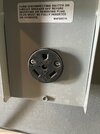Buying a 3 year old house with this outlet in the garage. I thought it was for previous owners golf cart, but that plugs in elsewhere. This for a boat or a trailer? Anyone use this type of outlet to charge? Can I use it to charge my Y any faster than a regular 110 outlet? I’ve found an adapter that can connect to my mobile charger via my NEMA 14-50 connector, willI catch anything on fire?
View attachment 888986View attachment 888986
Yeah, adapter for a NEMA14-50 connector. Um. Not a good idea. In fact, a very bad idea.
Here's my go-to plot of this and that:
File:NEMA simplified pins.svg - Wikipedia
So, my general understanding of how a NEMA14-50 is used, at least in 240 VAC applications, is that one pin is safety GND, one pin is Neutral, and the other two pins are 120 VAC, 180 degrees out of phase with each other, so that the voltage between them is 240 VAC.
This mimics rather closely how houses in the US/Canada are wired: Each house tends to get split phase power, with two hots, each 120 to neutral, and 240 between the two hots. At the breaker panel, alternating horizontal slots get one hot or the other. A single-width breaker provides a single hot at 120 to neutral/ground (those latter two are bonded together at the main breaker panel); a double-width breaker provides two hots with 240 VAC between the hots, for use when charging electric cars, running a clothes drier, or the furnace blower/air conditioning system.
As others have noted, your socket is a NEMATT-30. The roundy top pin is safety ground, the bottom left blade is a 120 VAC hot, and the bottom right blade is Neutral. There's no 120 VAC anywhere near this thing.
The NEMA14-50 adapter in your Mobile Connector kit is expecting 240VAC/208VAC (depending upon whether your house is powered for split phase or three phase, respectively), and nothing else but.
So, deep breath: Say one has an RV. The RV is likely wired like a
house, and whatever passes for a breaker panel in the RV is expecting two hot phases and a neutral. The neutral gets connected to this heavy bus bar. A NEMA14-50 connects to
two hots; each of those two hots goes to each of two additional bus bars, and those two bus bars connect to alternating slots where the breakers plug in. So, take a breaker, plug it into a slot, and there's a terminal where a wire plugs in to the breaker on one end and goes to whatever-it-is (like, say, the lights or a socket) at the other end, and there's 120 VAC between that hot wire coming off the breaker and the neutral bus.
Plug said breaker into the
next slot and, instead of getting hot A (say), one gets hot B. which is
also 120 VAC to neutral.
Now, get a double-wide breaker that plugs into two slots, there's two wires coming out. Since Phase A and Phase B are of opposite phase, there's 240 VAC between those two wires - and each wire is 120 VAC to neutral.
Now, suppose one has some load that needs 120 VAC at 30A. Haul out the TT-30, which is hot, neutral, and ground, and the hot is 120 VAC to neutral and install that; why not, it's a legit 120 VAC, 30A circuit. Next, say one has an RV that happens to have no 240 VAC loads, or one doesn't care about the 240 VAC loads. One gets a funky adapter that connects the one and only hot on the TT-30 to
both of the hots on a NEMA14-50, and plugs the RV into that. Well... the 120 VAC sockets and lights will work in the RV, but any 240 VAC loads will have Zero volts into them, since the two phases on the two hot connectors of the NEMA14-50 adapter in this case are the
same wire/phase, and has zero volts across the 240 VAC load. No Air Conditioning for
You, and the clothes drier in the RV won't be working, thank you very much. But you'll have lights, and maybe the microwave will work, so, why not?
But... if you use that funky adapter that you mentioned, what you'll get when you try to charge the Tesla is... nothing. The car won't see any voltage, or (alternatively) it'll see something weird with the voltages to ground/neutral, and will throw a fault.
The only two strictly 120 VAC adapters available for the Gen 2 Mobile Connector is one for a NEMA5-15 (good for 12A on a 120 circuit with a 15A breaker) or one for a NEMA5-20, which has a right-angle blade, and is good for 16A on a 120 circuit with a 20A breaker.
Typical charge speeds for
those two 120 VAC adapters is 4-5 miles of charge per hour with the NEMA5-15 and 4-6 with the NEMA5-20: See the site,
https://shop.tesla.com/product/gen-2-nema-adapters.
A better bet, as has been noted here, is to snag oneself an electrician, ditch the TT-30 connector, get some heavier wire and put in an actual NEMA5-50 with a 60A breaker behind it at 240 VAC. With the Mobile Connector, you'll get a maximum of 30A. If you want better, you either get a Tesla Wall Connector, which, with a 60A circuit, can do 48A, or some other party's J1210 wall connector, and use that, at whatever current it can do (the car's max is 48A).





